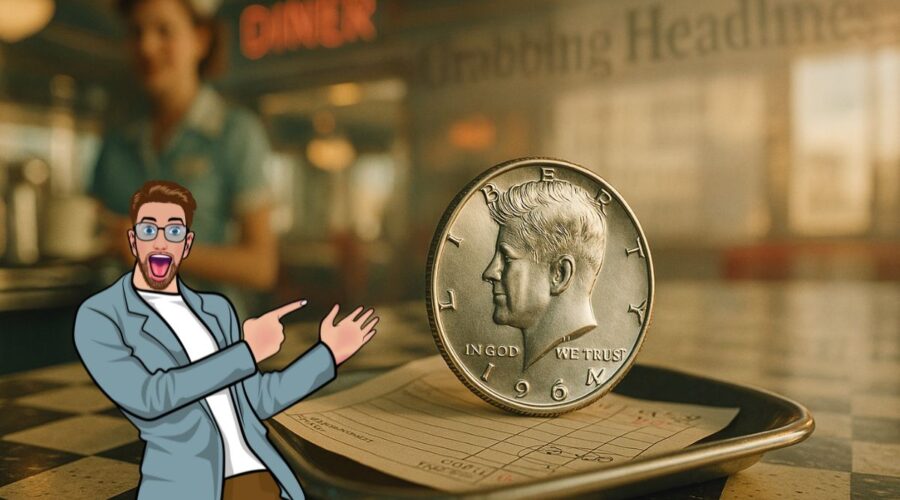Kennedy Coin Tipped at Diner Now Grabbing Headlines Nationwide
A routine shift at a small-town diner was transformed into a masterclass in numismatic serendipity. On a quiet morning, a waitress at Mel’s Country Diner in Wadsworth, Illinois discovered something extraordinary—a Kennedy half-dollar, carelessly left behind by a customer.
But this wasn’t just any fifty-cent piece. The coin, later verified by a local coin dealer, is an early silver Kennedy half-dollar in pristine condition—an unexpected windfall that ignited media buzz across the nation.
The Moment That Changed Everything
- Date & Location: A few weeks ago at Mel’s Country Diner, Wadsworth, Illinois.
- The Discovery: Cleaning up a table after the breakfast rush, the waitress noticed a shiny Kennedy half-dollar among the usual coins .
- Immediate Reaction: Intrigued by its luster and apparent age, she handed it to a local collector for assessment.
Why This Coin Could Be Worth More Than 50¢
The coin’s appeal lies in a combination of silver content, condition, and possible mint error:
- Silver Value: Early Kennedy half-dollars (1964–1970) contain silver—making them valuable beyond face value.
- Pristine Condition: Described as “in excellent condition,” an uncirculated example can fetch hundreds or even thousands.
- Error Potential: Rare minting errors—like missing designer initials or die flaws—dramatically increase rarity and value.
Table: Estimated Value by Type & Condition
| Coin Type | Condition | Silver Content | Estimated Worth |
|---|---|---|---|
| 1964 Kennedy Half Dollar | Uncirculated MS‑65+ | 90% silver | $10–$20 (silver melt) |
| 1965–1970 Silver-Clad | Mint State | 40% silver | $3–$10 (silver melt) |
| Rare Error / Special Mint Set (SMS) | MS‑65 or higher | Varies | $500–$47,000+ |
| Newly Discovered Rare Find | Pristine or Error Mint | Varies | Speculative, possibly high |
Note: Values in this table are rough estimates based on metal content and numismatic premiums.
Expert Input: Dealers & Collectors Weigh In
A local coin dealer, after examining the coin under magnification, confirmed it matched traits of an early silver Kennedy half-dollar preserved in near-mint condition. Even without error features, pristine silver coins can attract buyer premiums.
However, if minting anomalies or low mintage dates are confirmed (e.g., 1964 SMS examples), values can soar—one famously sold for $47,000 in 2016 .
Why the Story Captured National Attention
- Teenage Paradise: A modest diner setting + an unlikely windfall = every wage-earner’s fantasy.
- Collector Frenzy: The numismatic community lit up—rare coin stories always do.
- Media Magnetism: The tale of a hidden treasure, plus hopeful speculation, ensured headlines nationwide .
What Came Next: Auction Alert and Verification
Following validation, the coin was submitted to a national auction house. Security footage revealed the tipper—a senior man paying with “cash” and walking out promptly, adding mystery and intrigue. High bidder interest is expected, especially if grading reveals exceptionally high mint-state or error traits.
Numismatic Context & Historic Values
According to recent market data:
- 1964 SMS Kennedy half-dollar: Sold for $47,000 in 2016.
- 1972-D half-dollar ‘No FG’ error: Sold for $2,485.
- Other rare examples (e.g., copper-nickel proofs, fancy toning): Range from $1,000–$150,000 .
This context suggests that even a well-preserved but common-date silver coin could fetch several thousand dollars, especially in top mint grades.
5 Reasons This Tale Resonates
- Hope & Dreams – Ordinary change → extraordinary wealth.
- History in Hand – A Kennedy half-dollar connects to American legacy.
- Mystery – Who left it, and why? Public speculates.
- Financial Windfall – Silver + rarity = strategic asset.
- Collectible Fever – Media buzz drives collector interest—and prices.
What began as exact change in a “Mom and Pop” diner has blossomed into a headline-sweeping collector sensation. As this unassuming Kennedy half-dollar moves through authentication and auction channels, its journey underscores the enduring allure of hidden treasure. Whether it brings thousands or tens of thousands, the story proves that one overlooked coin can spark a nationwide frenzy—and maybe, just maybe, change a life.
FAQs
Could this coin truly be worth over $1,000?
Yes—if it’s in mint state and carries a rare mint error or proof finish, values can jump from hundreds to thousands.
Should someone holding such a coin submit it for grading?
Absolutely. Third-party grading (e.g., PCGS or NGC) verifies condition and error status, increasing trust and auction value.
Will coin values drop if more similar coins appear on the market?
Unlikely. Rare error conditions and perfect mint-state examples remain scarce—demand among collectors tends to outpace supply.


Leave a Reply